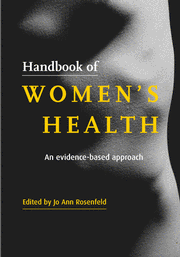Book contents
- Frontmatter
- Contents
- List of contributors
- Common abbreviations used in the text
- Normal blood values in women and during pregnancy
- Introduction
- 1 Singular health care of women
- Preventive care
- 2 Preventive care of adolescents
- 3 Preventive care of adults(19 to 65 years)
- 4 Preventive care for older adults
- 5 Cigarette smoking and cessation
- 6 Nutrition
- 7 Exercise
- Psychosocial health
- Sexuality
- Genitourinary medicine
- Breast disorders
- Psychological disorders
- Common medical problems
- Index
4 - Preventive care for older adults
Published online by Cambridge University Press: 28 October 2009
- Frontmatter
- Contents
- List of contributors
- Common abbreviations used in the text
- Normal blood values in women and during pregnancy
- Introduction
- 1 Singular health care of women
- Preventive care
- 2 Preventive care of adolescents
- 3 Preventive care of adults(19 to 65 years)
- 4 Preventive care for older adults
- 5 Cigarette smoking and cessation
- 6 Nutrition
- 7 Exercise
- Psychosocial health
- Sexuality
- Genitourinary medicine
- Breast disorders
- Psychological disorders
- Common medical problems
- Index
Summary
Primary preventive measures for older women must be accomplished early in life to make an impact later in life. Prevention for the older person includes maintaining quality of life, preserving function, preventing collapse of family support systems, and maintaining independence in the community.
Primary preventive measures are optimally accomplished early in life to make an impact later in life.
Goals of preventive care for the older woman
The percentage of US adults older than age 65 years is growing rapidly and expected to almost double between 1995 and 2030 (12.8 to 20 percent).
Life expectancy for women is longer than that of men, at all ages older than age 65 years. By age 85, only 45 men will be alive for every 100 women. This significantly changes the social environment in which older women live. Understanding the specific needs and circumstances of an individual woman helps to guide preventive health decisions.
The annual physical examination encompasses screening and preventive counselling. Both primary preventive measures (i.e., interventions targeted at preventing specific conditions in asymptomatic persons) and secondary preventive measures (i.e., screening for early detection and treatment of modifiable risk factors or preclinical disease) are described.
- Type
- Chapter
- Information
- Handbook of Women's HealthAn Evidence-Based Approach, pp. 42 - 71Publisher: Cambridge University PressPrint publication year: 2001



